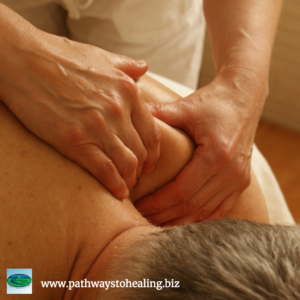By: Dr. Alyssa Musgrove – Pathways to Healing
 The shoulder is the most complex joint in the human body. Studies show nearly 90 percent of the population will tear or damage their rotator cuff, labrum and/or shoulder capsule at some point in their lives. Most of us are unaware of how important the shoulder is until we injure it. Shoulder pain of any sort can make daily activities like combing your hair, brushing your teeth, sleeping and getting dressed complicated and painful.
The shoulder is the most complex joint in the human body. Studies show nearly 90 percent of the population will tear or damage their rotator cuff, labrum and/or shoulder capsule at some point in their lives. Most of us are unaware of how important the shoulder is until we injure it. Shoulder pain of any sort can make daily activities like combing your hair, brushing your teeth, sleeping and getting dressed complicated and painful.
The reason for the high prevalence of shoulder injury is due to the anatomy and structure of the shoulder. The human shoulder is made up of a complicated system of bones, joints, connective tissue and muscles. The shoulder’s ball and socket joint allow for excellent mobility, but unfortunately a joint cannot be both highly stable and highly mobile. In the case of the shoulder, mobility comes at the expense of stability.
There are many ways we can injure the shoulder, such as falling, throwing, lifting, painting, cleaning, swinging a tennis racket or golf club. Problems can also occur from natural wear and tear over time. One of the biggest challenges in managing shoulder pain is finding the origin. Shoulder pain can be musculoskeletal in nature, it can be referred pain from a visceral organ, it can result from overuse (as in the cases of bursitis or tendonitis), there can be tears in the connective tissue, bone spurs or muscle imbalance.
What’s more, the shoulder is slow to recover from injury. Some research shows only about half of all new shoulder pain episodes achieve complete recovery within six months. Factor in aging, chronic health conditions that slow healing (like diabetes), and hobbies or jobs that are repetitive in nature and increase the risk of re-injury, and it is easy to see why many don’t make a full recovery from shoulder pain.
 Chiropractors, physical therapists, acupuncturists and orthopedists are just a few specialists who can help ease shoulder pain. The use of manipulation, mobilization, magnetic field therapy, TENS unit and modalities like cold lasers can help tremendously, but some shoulder injuries do require surgery. If your shoulder pain has not resolved on its own by resting 1 to 2 weeks, you should check with your doctor. However, that does NOT mean you should wait two weeks before seeing someone about your shoulder. Some people ignore nagging pain for weeks or even months, but the sooner you see a doctor the quicker you can begin treatment and resolve the issue before surgery becomes the only option.
Chiropractors, physical therapists, acupuncturists and orthopedists are just a few specialists who can help ease shoulder pain. The use of manipulation, mobilization, magnetic field therapy, TENS unit and modalities like cold lasers can help tremendously, but some shoulder injuries do require surgery. If your shoulder pain has not resolved on its own by resting 1 to 2 weeks, you should check with your doctor. However, that does NOT mean you should wait two weeks before seeing someone about your shoulder. Some people ignore nagging pain for weeks or even months, but the sooner you see a doctor the quicker you can begin treatment and resolve the issue before surgery becomes the only option.
When it comes to keeping our shoulders healthy, an ounce of prevention is truly worth a pound of cure. Here are a few ways to protect your shoulders on a daily basis:
- When working with your arms overhead, take small breaks to let the shoulder recover.
- Do not reach in the back seat and lift a heavy purse, bag or briefcase at an awkward angle in order to get it to the front seat.
- If you are facing a challenging task, request a helping hand. Do not feel insecure about asking for help. It is better to be safe than sorry!
- Follow an exercise program that maintains strength in your shoulders and contains opposition exercises to keep the shoulder muscles balanced. For example, if you are going to do push-ups, make sure you also do pull-ups. In this way, both sides of the body are strengthened for optimal balance and pain-free function.
The following stretches can be done at home to help further balance the shoulder joint and prevent simple injuries:
90, 90 shoulder stretch
Stand in your doorway, holding your arms up so your elbow is at a 90-degree angle and your arm forms a 90-degree angle to your body at the shoulder. Place each hand on the side of the door frame making sure your wrist and elbow also make contact with the door frame. Place both feet in the doorway and lean forward as you brace yourself against the door frame. Make sure your neck is aligned with your spine. Do not drop your chin — keep it parallel to the floor. Hold the stretch for 20-30 seconds and repeat 2-3 times.
Pendulum exercise
Bend at your waist with one hand hanging down and your other arm supporting your upper body on a table or chair. Relax your hanging arm completely and swing it gently and slowly in a figure 8 direction in both clockwise and counterclockwise. You can grasp a light weight, such as a soup can, while smoothly swinging the arm. Circle 10-15 times each direction, do 1-2 sets per day.
Finger wall walks
Face a wall. Using one arm at a time, slowly walk your fingers up the wall, moving your arm upward as far as you can reach comfortably. Then walk your fingers gradually back down the wall (STOP if there is any point of pain). Repeat 10-20 times.
Cross-body reach
Lift one arm at the elbow and bring it up and across your body and hold a stretch for 20-30 seconds. Each day try working on reaching further across your body in order to increase mobility.
Towel stretch
Take a small towel that is about 3 feet long and hold each side with your hand. Bring the towel behind your back and grab the opposite end with the other hand. Pull the top arm upward while also pulling the other lower arm downward to stretch your shoulders. You can also hold the towel on both ends while pulling with both arms to keep the towel tight and raise your arms in front of you and above your head, keeping elbows straight at all times.
 Pathways to Healing specializes in holistic chiropractic care. Dr. Alyssa Musgrove draws on a variety of techniques, including chiropractic, kinesiology, nutrition, food allergy testing and lifestyle counseling to assist clients in achieving optimal health and wellness in one setting. Pathways to Healing is located at 1022 Founders Row, Lake Oconee Village, Greensboro. The office can be reached at 706-454-2040.
Pathways to Healing specializes in holistic chiropractic care. Dr. Alyssa Musgrove draws on a variety of techniques, including chiropractic, kinesiology, nutrition, food allergy testing and lifestyle counseling to assist clients in achieving optimal health and wellness in one setting. Pathways to Healing is located at 1022 Founders Row, Lake Oconee Village, Greensboro. The office can be reached at 706-454-2040.